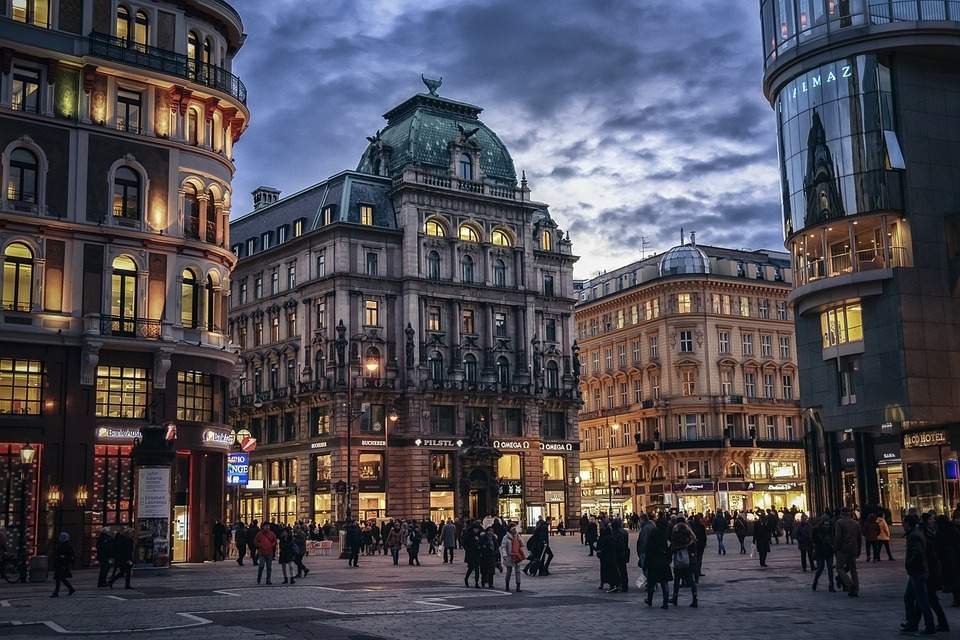
At the heart of Europe lies a city rich in both historical treasures and creative energy, writes Rasika Sittamparam
‘The Viennese have the efficiency of the Germans and the warmth of the Italians,’ says our guide, Helena Hartlauer from the Vienna Tourist Board, before we step out into the relaxed Innere Stadt from the lavish Hotel Sacher – the accommodation of choice for Grace Kelly, JFK and the Queen while visiting the city. We walk past an umbrella holding crowd outside the hotel’s café. ‘They are waiting for the Sachertorte,’ says Helena. The world-famous chocolate cake (which I had had for breakfast) was invented there. The firm cake, coated with dense cocoa icing, has discreet layers of apricot jam gluing the sponge to its ganache exterior and is served with a dollop of rich cream. It is definitely worth the wait, even in the rain.
We arrive for dinner at Tian, the city’s new favourite Michelin-starred restaurant. Wiener schnitzel is not on the menu: we’re in a restaurant founded by Europe’s best vegetarian chef, Paul Ivic. Each course opens more doors to fine dining with a range of roots, fruits, flowers and grains.
I ask Ivic how everything could look and taste so good. ‘Every ingredient was cooked as if it were meat; I am no vegetarian myself,’ he laughs. Further exploration reveals the city’s Baroque buildings with dramatic statues and gold and teal highlights. A stone’s throw from the hotel is St Stephen’s Cathedral, an imposing 136m-high gothic building with blue-gold Roman mosaic on the roof. No matter how ornate or reverent, many of Vienna’s icons seem to come with a twist, like Tian’s meatless menu.
The entrance of the cathedral once held the thigh bone of a mastodon found when its foundations were dug in the 1400s – granting it the moniker ‘The Giant’s Door’. No mammoth remains today, but there is a network of catacombs holding the tombs of the Habsburgs, bishops and an ossuary of the victims of 1679’s Great Plague of Vienna. Today’s Vienna has a knack for turning anything sombre or historical into whimsical art – this is, after, all the land of Gustav Klimt, the painter who co-founded the Vienna Secession in 1897 to rebel against conservatism and historicism.
True to that spirit is Tiefe Kümmernis, a Viennese art historian who gives private tours of the Kunsthistorisches Museum in drag. After a thought-provoking tour of the largest collection of Bruegels in history, Kümmernis leads us into a room with nameless objects in a maze-like setting. This exhibition, curiously named Spitzmaus Mummy in a Coffin and Other Treasures, is the curatorial debut of film director Wes Anderson and his author and illustrator wife, Juman Malouf.

Tiefe Kummernis (in drag), photography by Photo Benhamin Rowles (c) KHM-Museumsverband – Claudia Rohrauer
‘This is the Spitzmaus mummy,’ says Kümmernis, pointing to the tiniest of Egyptian tombs illustrated with a shrew. ‘It’s empty,’ he whispers, as he notices visitors attempting a painstaking crouch to peer into the low-lying exhibit.
This is a city where modernism doesn’t only challenge history, but co-exists with it too. At Köchert’s jewellery store I hold the necklace of Empress Sisi, which was found in the remains of her burnt castle after the Vienna Uprising. The Viennese are some of the world’s most sophisticated coffee drinkers, with a café culture rivalled only by that of Paris.
I head to a grand-looking coffee house and order a melange, which is similar to a cappuccino, but there are 44 other ways you can have your coffee. I listen to Alban Berg’s sonata being played on the grand piano, a soulful accompaniment to the bonhomie of the Sunday crowd. The melange drains, revealing the bottom of my cup. I instantly dread my imminent retreat to the Big Smoke.
Rasika Sittamparam writes for Spear’s







